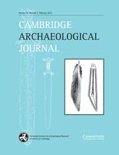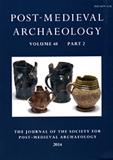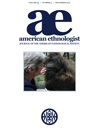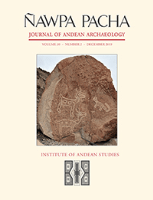
Archaeology Ethnology and Anthropology of Eurasia
Scope & Guideline
Bridging Disciplines to Uncover Eurasian Narratives
Introduction
Aims and Scopes
- Interdisciplinary Research:
The journal promotes interdisciplinary studies that combine archaeology, anthropology, and ethnology to provide a holistic understanding of Eurasian cultures. - Cultural Heritage and Identity:
A significant focus is placed on the exploration of cultural heritage and identity among various ethnic groups in Eurasia, examining how historical narratives shape contemporary identities. - Technological Advances in Archaeology:
The journal frequently publishes research that incorporates modern technological methods such as geophysical surveys, isotopic analysis, and multispectral imaging to enhance archaeological findings. - Chronological and Contextual Studies:
Studies that delve into the chronological frameworks and contextual analyses of archaeological sites, artifacts, and cultural practices are central to the journal's scope. - Human-Animal Relationships:
Research on the relationships between humans and animals, including domestication, subsistence strategies, and ritual practices, is a recurring theme. - Paleolithic to Medieval Transitions:
The journal covers a wide temporal range from the Paleolithic to medieval periods, analyzing socio-economic and cultural transitions across different epochs.
Trending and Emerging
- Paleogenetics and Migration Studies:
There is a growing interest in paleogenetic research and its implications for understanding human migration patterns across Eurasia, reflecting advances in genetic analysis technologies. - Cultural Resilience and Adaptation:
Studies examining how communities adapt and maintain cultural practices in the face of environmental and social changes are increasingly prominent, emphasizing resilience. - Material Culture and Technological Innovation:
An emerging focus on the analysis of material culture, particularly technological innovations in ancient societies, is evident, exploring how these innovations influenced social structures. - Environmental Archaeology:
Research in environmental archaeology is on the rise, with a focus on how past human activities have shaped and interacted with their environments, addressing themes like climate change and resource management. - Public Archaeology and Community Engagement:
There is an increasing trend towards public archaeology, emphasizing the importance of community engagement and the dissemination of archaeological knowledge to the public.
Declining or Waning
- Traditional Ethnographic Studies:
There has been a noticeable decline in papers focused solely on traditional ethnographic studies, as the journal increasingly emphasizes interdisciplinary approaches that integrate archaeological and anthropological perspectives. - Focus on Isolated Cultures:
Research concentrating on isolated or singular cultural narratives has waned, with a growing preference for studies that address broader cultural interactions and connections between Eurasian societies. - Narrow Regional Studies:
Papers that focus on very specific regional studies without broader implications or connections to wider Eurasian contexts are becoming less common. - Historical Archaeology of Recent Centuries:
Attention to historical archaeology pertaining to the last few centuries has decreased, with more emphasis being placed on prehistoric and early historic periods.
Similar Journals

CAMBRIDGE ARCHAEOLOGICAL JOURNAL
Illuminating the Past, Inspiring the FutureThe Cambridge Archaeological Journal, published by Cambridge University Press, is a premier academic journal dedicated to archaeology and cultural studies. With an ISSN of 0959-7743 and an E-ISSN of 1474-0540, it has established itself as a leading platform since its inception in 1991, showcasing groundbreaking research that significantly contributes to our understanding of human history and cultural heritage. The journal currently ranks in the top quartile (Q1) across various categories, including Archaeology and Cultural Studies, underlining its impact and relevance in the field. The impact factor reflects its esteemed position, with Scopus ranks placing it within the 90th to 93rd percentiles among its peers. Researchers, professionals, and students alike benefit from its insightful analyses and interdisciplinary approaches, making it an essential resource for advancing knowledge in archaeology and related fields. The journal is based in the United Kingdom, at the Edinburgh Building, Shaftesbury Rd, CB2 8RU, Cambridge, England, and continues to drive scholarly conversations through its commitment to excellence and innovation in archaeological studies.

Pamatky Archeologicke
Elevating the field of archaeology with distinguished contributions.Pamatky Archeologicke is a premier journal dedicated to the field of archaeology, published by the Academy of Sciences of the Czech Republic, Institute of Archaeology. Renowned for its rigorous scholarship and insightful contributions, the journal holds a distinguished position within the academic community, featured in the Q1 category of both archaeology and arts and humanities as of 2023. With impactful research articles that span a broad spectrum of archaeological inquiry, Pamatky Archeologicke serves as an essential resource for researchers, professionals, and students dedicated to understanding cultural heritage and archaeological methodologies. The journal enjoys a significant Scopus ranking, having achieved an impressive percentile ranking in both arts and humanities and social sciences disciplines. Although it currently does not offer open-access options, the journal remains committed to advancing the field of archaeology through high-quality research and critical discussions. Its scholarly contributions are crucial for fostering knowledge and innovation in the understanding of human history and prehistory.

Slovensky Narodopis-Slovak Ethnology
Unveiling Ethnological Insights from SlovakiaSlovensky Narodopis-Slovak Ethnology is a leading academic journal dedicated to the exploration of ethnology and cultural studies, published by the Slovak Academy of Sciences at the Institute of Ethnology. With an Open Access policy since 2013, it strives to make high-quality research readily accessible to a global audience, enhancing the dialogue around Slovak cultural heritage and broader anthropological topics. The journal holds a notable position in the field, currently ranked Q2 in anthropology for 2023, indicating its substantial contribution to the discipline. It is indexed in Scopus, with a current rank of 245 out of 502 in the Social Sciences category, reflecting its value within the academic community. Researchers and students alike can look forward to a rich array of original research articles, reviews, and essays that not only delve into Slovak ethnology but also engage with international perspectives, thereby enriching the understanding of cultural dynamics and practices.

Archaeologia Baltica
Fostering Dialogue on Cultural HeritageArchaeologia Baltica, published by the Institute of Baltic Region History & Archaeology at Klaipeda University, stands as a premier platform in the field of archaeology, with a specific focus on the Baltic region. This esteemed journal, which boasts a Q1 ranking in both the Arts and Humanities and Archaeology categories as of 2023, serves as a critical resource for scholars, researchers, and students dedicated to the exploration of archaeological horizons. Featuring an array of original research articles, reviews, and theoretical discussions, it aims to advance knowledge and foster dialogue in the diverse fields of archaeology. Though currently not an open-access publication, Archaeologia Baltica enjoys a commendable position in the Scopus rankings, underscoring its importance in shaping contemporary archaeological discourse. The journal not only reflects rigorous academic standards but also invites contributions that encourage collaborative efforts in the study of our shared cultural heritage.

Post-Medieval Archaeology
Fostering Scholarly Dialogue on Archaeological DiscoveriesPost-Medieval Archaeology is a distinguished academic journal published by ROUTLEDGE JOURNALS, TAYLOR & FRANCIS LTD, focusing on the rich tapestry of human history from the post-medieval period through the lens of archaeology. With a proud publication history spanning since 1967, this journal addresses the integration of archaeological findings with historical narratives, contributing significantly to the field of archaeology and history. The journal holds an impressive categorization within the Q2 and Q3 quartiles for Archaeology and History in 2023, showcasing its commitment to academic excellence and relevance within these disciplines. Researchers and professionals alike will find value in its critical examinations and innovative methodologies that illuminate the past, making it a pivotal resource for those engaged in archaeological research. As an essential platform for scholarly debate and dissemination, Post-Medieval Archaeology continues to advance the understanding of post-medieval contexts and material culture, fostering discussions that resonate through various areas of the arts, humanities, and social sciences.

AMERICAN ETHNOLOGIST
Navigating the Complexities of Social PracticesAMERICAN ETHNOLOGIST, published by Wiley, stands as a prominent platform in the field of anthropology, with a distinguished reputation underscored by its Q1 ranking in the 2023 Category Quartiles and a notable position in the 79th percentile among its peers. With its foundation dating back to 1974 and set to continue until 2024, this journal serves as a vital resource for researchers, practitioners, and students devoted to exploring cultural dynamics and social practices across diverse communities. The journal is characterized by its commitment to advancing theoretical discussions and empirical scholarship in ethnology and related disciplines. Targeted contributions include in-depth studies, critical reviews, and innovative methodologies that engage with pressing cultural issues. Although it does not offer Open Access, the journal’s rigorous peer-review process and high-impact articles ensure the dissemination of valuable insights, enhancing scholarly engagement and professional discourse. Its ISSN is 0094-0496 and E-ISSN is 1548-1425, emphasizing its dual format accessibility, which facilitates wider readership within the anthropology community.

Nawpa Pacha
Innovating Methodologies for Modern Archaeological Challenges.Nawpa Pacha, a prestigious journal published by Taylor & Francis Ltd, stands as a significant platform for advancing research in Archaeology within the fields of Arts and Humanities. Since its inception in 2019, it has rapidly established itself with an impressive impact, evidenced by its categorization in the Q1 quartile for Archaeology and its significant rankings—placing it at Rank #88 in the Arts and Humanities category and Rank #86 in the Social Sciences. Published in the United Kingdom, the journal aims to foster interdisciplinary dialogue and promote scholarly work that contributes to the understanding of archaeological heritage and practices. Researchers, professionals, and students alike will find this journal indispensable for disseminating innovative methodologies, theoretical frameworks, and case studies that push the boundaries of archaeological inquiry. Whether seeking to explore historical narratives or contemporary archaeological challenges, Nawpa Pacha serves as a vital resource in the ever-evolving landscape of archaeological research.

ARCHAEOLOGY IN OCEANIA
Uncovering the Rich Tapestry of Oceania's PastARCHAEOLOGY IN OCEANIA, published by Wiley, is a leading journal that delves into the rich and diverse archaeological landscape of the Pacific region. With a commitment to advancing knowledge in anthropology and archaeology, this esteemed publication has been pivotal in shaping scholarly discussions since its inception in 1966. Spanning generations of research, it has seen converged years of publication from 1966 to 1980 and from 2002 to 2024. With an impressive Scopus ranking placing it in the top quartiles across multiple categories - including Q2 in Anthropology and Q1 in Archeology (arts and humanities) - the journal distinguishes itself as a must-read for researchers, professionals, and students alike. Although it operates on a subscription model, its rigorous peer-reviewed articles and comprehensive studies contribute significantly to understanding the past of Oceania, making it an essential resource for those invested in this vibrant field of study.

Cahiers Mondes Anciens
Advancing Scholarship in Ancient StudiesCahiers Mondes Anciens is a distinguished Open Access journal dedicated to advancing the field of ancient studies, encompassing a wide array of disciplines such as archaeology, history, and cultural heritage. Published by CAHIERS MONDES ANCIENS, based in Paris, this journal has been providing seamless access to groundbreaking research since its inception in 2010, embodying a commitment to democratizing knowledge within the academic community. With an ISSN of 2107-0199, Cahiers Mondes Anciens offers a platform for researchers and scholars to share innovative findings, critical analyses, and interdisciplinary approaches that enrich our understanding of the ancient world. The journal is renowned for its rigorous peer-review process, ensuring the highest standards of scholarship. By fostering a vibrant community of academics, it plays a crucial role in the ongoing discourse surrounding ancient civilizations, making it an essential resource for professionals, students, and enthusiasts alike.

Fornvannen-Journal of Swedish Antiquarian Research
Fostering Dialogue on Sweden’s Archaeological LegacyFornvannen - Journal of Swedish Antiquarian Research is a distinguished peer-reviewed journal dedicated to advancing the field of antiquarian studies through rigorous research and scholarship. Published by the Royal Academy Letters, History & Antiquities in Sweden, this journal has been a cornerstone of archaeological and historical discourse since its inception in 1978. It currently holds an esteemed position in the Q3 category in both Archaeology and History as per the 2023 assessments, reflecting its commitment to promoting high-quality academic contributions. With an ISSN of 0015-7813 and an E-ISSN of 1404-9430, Fornvannen provides insights into Swedish antiquities and serves as a vital resource for researchers and scholars eager to explore the nuances of archaeological and historical findings. Although not an open-access journal, it offers a comprehensive platform for the dissemination of knowledge within the fields of arts and humanities. As it continues its journey from 2011 to 2024, Fornvannen remains pivotal in fostering scholarly dialogue and enhancing our understanding of Sweden’s rich historical tapestry.